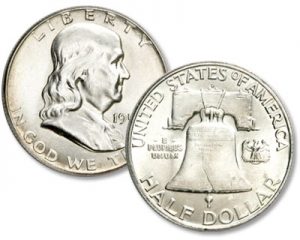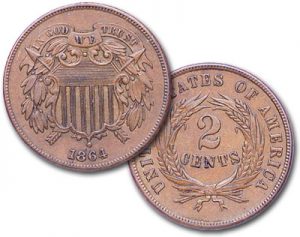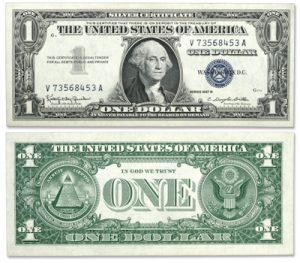Inscriptions on U.S. coins – now you see ’em, now you don’t!
Examine any coin in your pocket or purse today and you’ll find 6 different inscriptions… not counting mint marks. All 6 are required by law, and include liberty, united states of america, e pluribus unum, in god we trust, the denomination and the year of issue. The position on the coins may vary, but they’re all there!

Things weren’t always that uniform in the past. The presence of inscriptions has at times depended on the size of the coin, the denomination, the composition and even the wishes of certain individuals. On some coins, inscriptions have come… gone… and come back again!
The original 1792 guidelines
The first coin requirements were stated in the Coinage Act of 1792 authorizing establishment of the U.S. Mint and production of national coinage. Commonly called the “Mint Act,” it was signed into law by President George Washington, who took a great interest in America’s money and became a frequent visitor to the first U.S. Mint. This historic legislation mandated the following:
 One side of all coins would have an image “emblematic of Liberty,” the inscription liberty and the year of issue.
One side of all coins would have an image “emblematic of Liberty,” the inscription liberty and the year of issue.- The reverse side of all gold and silver coins would feature an image of an eagle and the inscription united states of america.
- The reverse side of copper cents and half cents would have an inscription expressing the denomination. The inscription united states of america was included as well since there was plenty of room.
Some of these original requirements have gone by the wayside. Cents, nickels, dimes and quarters no longer feature Liberty or the eagle on either side. And the reverse of 1948-1963 Franklin half dollars depicted just a tiny eagle to the right of the Liberty Bell. So small it’s hardly noticed!
The on-and-off presence of e pluribus unum
The motto e pluribus unum (Latin for “out of many, one” to signify unity) first appeared on U.S. coins over 220 years ago in 1795 on $5 gold pieces. It was gradually added to other U.S. gold coins as well as silver issues. But then it was dropped from these coins during the 1830s.
Decades later in 1873, a coinage act made the Latin motto e pluribus unum a requirement on U.S. coins. It was gradually added to all circulating coins except gold pieces. And you’ll find this motto on all regular-issue U.S. coins minted today.
The intriguing saga of in god we trust
 The motto in god we trust first appeared on the 1864 Two-Cent Piece amid the religious fervor of the Civil War era. Legislation in 1865 directed the Treasury Department to put this religious motto on all gold and silver U.S. coins whose designs would readily accommodate it. The usual placement for the motto on 19th century coins was on a banner above the eagle on the reverse.
The motto in god we trust first appeared on the 1864 Two-Cent Piece amid the religious fervor of the Civil War era. Legislation in 1865 directed the Treasury Department to put this religious motto on all gold and silver U.S. coins whose designs would readily accommodate it. The usual placement for the motto on 19th century coins was on a banner above the eagle on the reverse.
The use of in god we trust on U.S. coins has not been without interruption. It disappeared from the 5¢ nickel in 1883 and did not reappear until the Jefferson nickel was introduced in 1938. Though 1866-1907 Liberty Head $10 and $20 gold coins featured the motto, the beautiful Saint-Gaudens $10 and $20 gold pieces made their debut in 1907 without in god we trust. It was a designer decision supported by President Theodore Roosevelt. However, Congress ordered the motto restored on these coins the following year and made the motto mandatory on all coin denominations that previously displayed it.

in god we trust is seen above ONE.
in god we trust has been in continuous use on all circulating U.S. coins since 1938. When a joint resolution of Congress in 1956 made in god we trust the national motto of the United States, the motto was mandated for use on all paper currency as well as coins. Its first appearance on U.S. paper money came with Series 1957 $1 Silver Certificates.
The “Godless” Presidential dollars
The Presidential dollars of 2007-2016 honored four presidents per year in order of service. They featured the first edge lettering on regular-issue dollar coins in over 200 years. When the series debuted in 2007, the year of issue, mint mark and mottos e pluribus unum and in god we trust were all inscribed on the edge of the coins. But before long, some Presidential dollars were found with no edge lettering at all!
It could be blamed on a two-step production process. After the obverse and reverse designs were struck in a single coin press operation, the Presidential dollars were moved to an edge-incusing machine that created the edge lettering. The coins without edge inscriptions simply missed this second step altogether… And then escaped the mint without detection! Without the religious motto in god we trust, these coins were dubbed the “Godless” dollars by the press…
However, some people objected to the religious motto being on the edge anyway. So in god we trust was moved to the obverse of the coins below the presidential portrait beginning in 2009.
“In God We Rust”
The Statehood quarter program was not without its own minting errors. A number of 2005 Kansas quarters have been found with a motto appearing to read in god we rust. It happened because the inscription is recessed on the dies – to produce raised lettering on the coins. On at least one die the first T in TRUST became filled with grease (used to lubricate moving parts of the press).
This and other lettering foibles have created many prized error coins, so it pays to keep your eyes open… Inscriptions continue to generate interest and intrigue for the coin collecting community!
Do you look closely at inscriptions on coins in your pocket, purse or collection – or on coins you consider acquiring? Please share your thoughts and suggestions with other collectors…




How can I find out about a 1958 D silver penny?
Hi Dolores, your best bet would be to find a reputable dealer locally who can inspect the coin up close to determine what you have. As most collectors know, the 1943 Lincoln Cent was made of steel, but I’m not aware of any silver Lincoln cents being made. So you should definitely find someone knowledgeable take a look. Happy New Year! -Rick